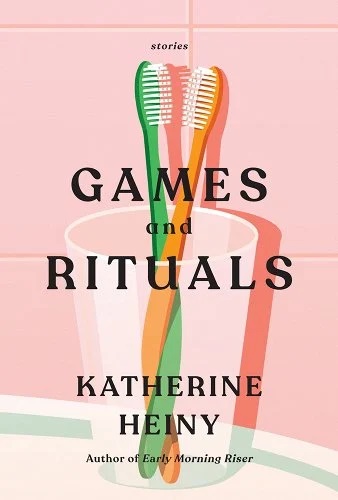[ad_1]
The pandemic changed many things. There’s no going back, no return to normal, because the normal we left behind doesn’t exist. We all see the world differently, whether we want to or not. We’ve entered the post-pandemic, and our art is beginning to reflect the shift. Authors echo these changes. They can confront those concerns directly with a past-tense pandemic, or by writing from within it, as a present. But the more profound impact on stories will be the sorts of narratives, the themes, the critiques, those stories confront. We saw in Jem Calder’s collection Reward System from July last year how disconnection, isolation, and a reflection on intimacy grew more important to the contemporary narrative. Although a very different collection, Katherine Heiny’s latest story collection, Games and Rituals, shares many of these post-pandemic characteristics. The book is an examination of domestic life, particularly marriage. Many of these characters are dealing with parent-child relationships. Family life, and those intimacies, are under the microscope.
Much of the world spent a year or two or three enclosed with the people we were supposed to be most intimate with. It seems only natural then that the interest now would be to put those relationships under scrutiny. Heiny’s new story collection tests the limits of these relationships over and over again, challenging the institutions of family and marriage.
The relationship between parent and child is perhaps the most intimate one. In the story “Turn Back, Turn Back,” actor Rob has come to resent his children for ending, or at least curtailing, his once burgeoning acting career, still just in its infancy when they were born. His wife works a corporate job and he stays home raising them. With the first one, he still has a sense of self because he’s able to attend auditions, but the second child is more difficult and prolongs his absence from the occupation. The story raises the concerns so many creative people feel as parents. The cost of parenting is sacrificing their art and their own aspirations. Rob, perhaps, acts out more than most people by running off with his acting partner. Lindy, his wife, “never wanted to live on the edge. She knew if you weren’t careful, you sailed right off.” And here is where this story connects to the post-pandemic experience: so many people did sail right off.
Marriage is the primary lens Heiny uses throughout the collection. We see couples in long marriages and new marriages and failing marriages and failed marriages. The home is the center stage for most of these stories, and in the shadow of the pandemic that makes sense. We’ve all just spent an enormous amount of time in these settings, and naturally those petty dramas are something of interest.
In the story “CobRa,” William and Rachel have entered their empty nest years. Rachel has taken up KonMari, tidying up the house on the advice of Marie Kondo’s book. She is unsettling William with her continued disposal of their possessions, and he refuses to participate. Their daughter asks him to protect her American Girl dolls, but they’ve already been ejected from their attic tomb. William is displeased by the sudden shift in their lives and goes as far as observing it was like they had “divorced and now he was married to Marie Kondo.” Rachel seemingly just wants William’s support. She wants him to want to KonMari. She asks him to participate hoping he’ll review his bookshelves. He’s unnerved by the idea and refuses to cull his books, a feeling that strikes relatively close to home. Throughout the story they are out of step with each other and even when she cleans the garage, William is disappointed to learn she has thrown away perfectly good, almost new snow tires. Heiny captures the domestic tension perfectly, revealing the most annoying faults of both characters. On one hand, it’s easy to sympathize with William as he watches his house get torn asunder and his possessions slowly disappear, but also with Rachel, who wants her husband present while needing a new beginning. The warning in the end comes when Rachel never achieves the catharsis she was promised. She wants renewal, but finds herself in the same place, albeit with somewhat fewer tchotchkes. The cost of marriage seems to be happiness.
“Pandemic Behavior” focuses directly on the pandemic. Daphne and her roommate Lohania become particularly paranoid at the onset of the global crisis, hoarding toiletries and leaving groceries in their cars to isolate for days on end. They are relative strangers, having become roommates only weeks before the pandemic begins. Perhaps this is a sly way of suggesting we were all strangers to each other until we were locked inside our houses together.
The marriage Heiny looks at through this story is that of Daphne’s employer, a professor she has been assisting with research. He continues to pay her even during the lockdown, and squares this morally by acknowledging she often did nothing even when she was at his house. Professor Rossignol has extreme faith in science to find a cure, but ultimately his many conditions lead to his death. His widow, Esther, reflects that neither she nor her husband believed in the afterlife. There is no reunion awaiting them, a fact she seems happy enough to accept.
Marriage is under the microscope in many ways, sometimes literally too. In “Bridesmaid, Revisited,” Marlee wears a bridesmaid dress to work, a decision she makes “being slightly hungover and experiencing a laundry crisis.” There are some common observations about how difficult it is to reuse such dresses, and how useless they are outside of weddings. Tessa, a wedding photographer in “King Midas,” has the experience of fighting off the advances of the father of the bride. The act of marriage, not just the institution, is condemned.
Tessa isn’t all that fond of the idea of marriage for herself, either. The father of her son wanted to marry, but she didn’t. She refers to him as a drunk truck driver, although he works in finance and lives in Manhattan, and her boyfriend, Oscar, is married with children of his own. Tessa tries to upsell her brides on morning-after shots, but without much luck. One bride goes as far to explain she has no interest in seeing her mother-in-law without makeup on. And in some sense, this is how marriage is portrayed in the collection. Marriage is the act of wearing makeup, covering up the cracks and wrinkles.
Bookending the collection are two stories that fall outside this framework. The opening story, “Chicken-Flavored and Lemon-Scented,” is about camaraderie and intimacy of coworkers at the DMV. Colette, Vic, and Alejandro aren’t family exactly, but they spend a lot of time with each other and know each other’s faults in the same way family members do. And in “Skybar,” the concluding story of the collection, isolated strangers are thrown together because of a flight delay. Fawn is intentionally alone, and helps out Meredith, who drinks too much. Here, they find intimacy in a wholly different way than a family. Both the first and last stories look outward, even as the main body of the collection is focused inwardly toward the home. The contrast amplifies the differences in these relationships.
We’re still in the early phases of creating post-pandemic art. Many stories will yet be told. But already we can see the trends and tropes, a critique of old institutions and a gaze inward on the lives we live at home. Games and Rituals is a collection challenging establishment ideals and revealing the ugliness of our intimate relationships.

FICTION
Games and Rituals: Stories
By Katherine Heiny
Knopf Publishing Group
Published April 18, 2023

[ad_2]
Source link

